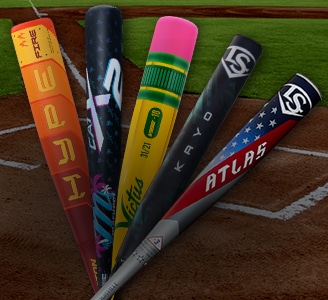WHY YOU NEED A HELMET
A batting helmet will help protect the batter’s head from a wild pitch, but they also provide protection from projectiles like foul balls when standing in the on-deck circle, errant throws while running the bases and the rugged nature of sliding into base.
While there is no such thing as a concussion-proof helmet, a batting helmet can help minimize impact and reduce the likelihood of a serious brain or head injury.
Most youth helmets are approved for protection against balls thrown up to 68 MPH, while high school players and up should use a helmet rated for ball impact of at least 90 MPH.
SIZING
An ill-fitting helmet not only compromises player safety, but can shatter confidence at the plate. So, to ensure protection and performance, here are some tips to determine the right sizes and features for your helmet.
In terms of sizing, most manufacturers vary in their batting helmet measurements due to differences in shell design and padding, but they’re pretty similar. If you don't have the ability to try on your helmet first, a good tip is to treat the process like you would when you buy a hat.
First, measure of the circumference of your head and correlate it to the closest size available. To do this, take a cloth measuring tape and measure the circumference of your head right above your ears.
While it’s important to check the sizing guides specified by each manufacturer, you can use the chart below as a general guide.
| AGE GUIDELINE | HEAD CIRCUMFERENCE | HAT SIZE |
|---|---|---|
| TEE BALL | 18 3/4" - 20 3/8" or 49cm - 53cm | 6" - 6 1/2" |
| YOUTH | 20" - 22 3/8"" or 52cm - 58cm | 6 3/8" - 7 1/8" |
| ADULT | 22" - 24 3/4" or 57cm - 64cm | 7" - 7 7/8" |
PROPER FIT
The best way to get a proper fit is to try on a helmet and perform a “shake test”, which you can do at your local DICK’S Sporting Goods. Place the helmet on your head and give it a few good shakes. If it moves around too much, try going down a size or consider buying a padding kit so you can guarantee a more accurate fit.
You also want to make sure that your helmet sits about an inch above your eyebrow and that it fits evenly on your head.
If it’s tilted up, you run the risk of taking a ball to the forehead when batting or running the bases. If its tilted too far forward, the back of your head will be exposed
A batter’s helmet should fit snugly all around, with no spaces between the pads and the athlete’s head. Athletes should NOT wear anything under a batter’s helmet. This includes a baseball hat.
One thing to remember is to never purchase a bigger helmet to grow into. Your head does not grow much past age 10. The danger of a helmet that is too big is that the helmet will move around on the head and lead to an injury.
ADDED PROTECTION
Baseball players are not required to wear an attached facemask, but it’s acceptable and may be a good idea, especially for younger athletes or those practicing with a pitching machine.
Double flapped helmets (helmets that cover both ears) are required in most leagues below the professional level, including youth/little league, high school, and college.
Extended jaw guards or “flaps" are also growing in popularity for athletes of all ages, as they offer extra protection from errant pitches without hindering visibility.
We've made it easy to find compatible facemasks and jawguards for our top baseball batting helmets. CLICK HERE to learn more!
Batting helmet face masks may come pre-attached or they may be sold separately for you to add using pre-drilled holes on your helmet. Be sure the mask is not intended specifically for fastpitch softball where the ball size is larger, as the wire spacing may be too large and compromise safety!
DICK'S PRO TIP: Its best to buy a facemask that is manufactured by the same brand that made your helmet. This will help avoid any problems with the attachment process.
DICK'S PRO TIP: Look for two button snaps on the lower corner of each side of the helmet front. That's where you can easily attach your chin strap.
DICK'S PRO TIP: All Helmets sold at DSG are NOCSAE certified.
OTHER IMPORTANT CONSIDERATIONS
Once you've determined the proper size, fit and added protection you'll need to bat your best, you'll need to consider some other important design and construction elements.










